Remote Learning Tips for Students: A Comprehensive Guide to Success

Ashley Merit
Content writer and editor for Netus.AI
Table of Contents
Remote Learning Tips for Students. The concept of remote learning, also known as distance education, has been in existence for quite some time, appealing to homeschoolers and those unable to attend physical schools. Advancements in technology have greatly enhanced this experience, enabling digital classrooms and real-time student-teacher interactions. These courses break down geographical barriers and offer students a diverse range of subjects to choose from, promoting inclusivity.
With the COVID-19 pandemic, remote learning has become an increasingly essential aspect of education. Students participating in distance learning programs must consider various factors to maximize their experience. To assist in navigating this educational landscape, several tips can prove highly effective for their journey.
Key Takeaways
- Remote learning offers diverse course options and flexibility for students.
- Technology advancements have improved digital classrooms and interactions.
- The COVID-19 pandemic has accelerated the significance of remote learning in education.
Remote Learning Tips for Students:
Students participating in remote learning should ensure they have the necessary tools and technology for effective learning. Staying engaged with teachers and peers through interactive platforms can help students feel more connected and maintain a semi-classroom environment.
Active participation in class is essential for understanding the curriculum and course material. By engaging in interactive sessions, students can better grasp topics and receive guidance on approaching projects and assignments.
In distance learning programs, it’s critical for students to focus on the subject matter beyond the provided study materials. As curriculums become more research-based, understanding the subject in its entirety will better prepare students for assignments and future education. Using online tools can help students manage their workload.
After completing lessons, students should review their work to identify any potential difficulties. Open communication with fellow students and teachers allows for clarification and further explanation when needed. Establishing study groups can also be beneficial for discussing lessons and clarifying doubts.
Taking advantage of technology can optimize remote learning experiences. Using videos, recorded lectures, and other innovative methods can supplement course materials and make learning more accessible.
It’s important to regularly check for homework and assignments on communication platforms. Timely completion of assignments reduces stress and the likelihood of resorting to academic dishonesty.
Approaching assignments with integrity is essential. Plagiarism can negatively impact a student’s academic career; therefore, understanding the basics of plagiarism and avoiding it is crucial. When citing external sources, students should provide proper citations and avoid copying content directly.
Utilizing a plagiarism checker before submitting assignments can help ensure original work and eliminate any potential plagiarized content. By implementing these strategies, students can navigate remote learning effectively and maintain a well-rounded academic experience.
Frequently Asked Questions
Effective Strategies for Time Management in Remote Learning
- Create a daily schedule, allocating specific time blocks for studying, breaks, and personal activities.
- Prioritize tasks and focus on completing the most important ones first.
- Use apps or online calendars to track deadlines and visualize time allocation.
Tips for Crafting an Ideal Home Learning Space
- Choose a quiet, well-lit, and comfortable space for studying.
- Keep learning materials and tools organized and easily accessible.
- Personalize the space with motivational quotes, photos, or plants.
Techniques for Enhancing Focus and Reducing Distractions in Online Classes
- Close unnecessary browser windows and disable notifications from social media or email.
- Use noise-cancelling headphones or background music to minimize external noise.
- Take short breaks and practice self-discipline to avoid multitasking.
Ways to Actively Engage with Course Material in a Remote Setting
- Participate in class discussions, asking questions, and sharing thoughts.
- Collaborate with classmates through study groups or virtual meetings.
- Utilize resources such as Strategies for Effective Remote Learning to enhance learning experience.
Balancing Remote Learning with Personal Life
- Set boundaries between study time and personal time.
- Develop and maintain a routine that encompasses both learning and leisure activities.
- Prioritize self-care and make time for physical exercise, hobbies, and social interactions.
Leveraging Technology for a Better Remote Learning Experience
- Become familiar with the features and tools of the learning management system used by your school or institution.
- Utilize digital resources such as video lectures, podcasts, and e-books for a multimedia learning experience.
- Employ productivity apps and online tools to streamline tasks and enhance organization.
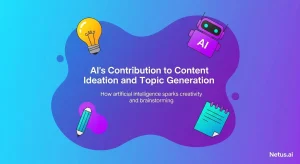
The Role of AI in Content Ideation and Topic Generation | NetusAI
AI’s contribution to content ideation and topic generation AI plays a crucial role in content creation and topic generation. Its effective application significantly reduces preparation
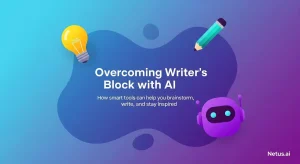
Leveraging AI to conquer writer's block | NetusAI
Overcoming writer’s block with AI Writer’s block affects all writers, new or experienced. Even for the most accomplished writers, this common and frustrating problem presents
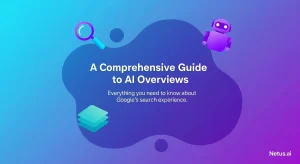
AI Overviews: A Comprehensive Guide | NetusAI
A Comprehensive Guide to AI Overviews Google has integrated AI Overviews into its search results as a knowledge panel. This feature acts like an AI
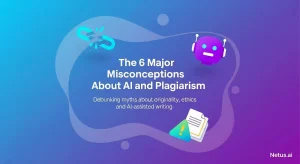
6 Common Misconceptions Regarding AI and Plagiarism | NetusAI
The 6 major misconceptions about AI and plagiarism Regarding AI and plagiarism, numerous myths, misconceptions and assumptions are circulating. Let’s distinguish between fact and fiction.
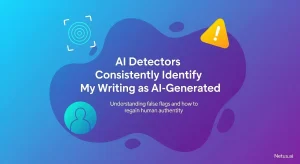
My writing is repeatedly flagged as AI generated by detection software | NetusAI
AI detectors consistently identify my writing as AI generated Even original, human-written content can face challenges from AI content detection false positives, impacting copywriters and
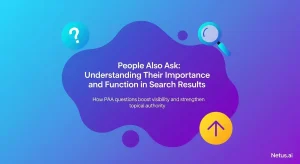
People Also Ask: Understanding their importance and function in search results
People Also Ask: Understanding their importance and function in search results A People Also Ask (PAA) search result is a zero-click Google response. It presents
